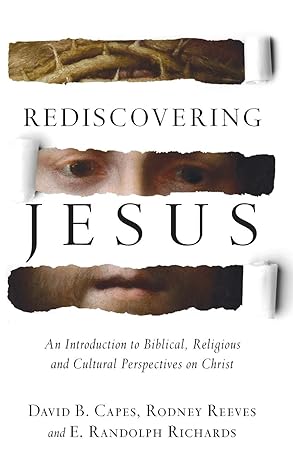A Brief Book Summary from Books At a Glance
by Mark Baker
About the Authors
David Capes is professor of New Testament at Houston Christian University; Rodney Reeves is dean of the Courts Redford College of Theology and Ministry and professor of biblical studies at Southwest Baptist University; E. Randolph Richards is dean of the School of Ministry and professor of biblical studies at Palm Beach Atlantic University (back cover).
Overview
Table of Contents
Part I
Introduction: Jesus in the Bible
1 Mark’s Jesus
2 Matthew’s Jesus
3 Luke’s Jesus
4 John’s Jesus
5 Paul’s Jesus
6 The Priestly Jesus
7 The Jesus of Exiles
8 The Apocalyptic Jesus
Part II
Introduction: Jesus Outside the Bible
9 The Gnostic Jesus
10 The Muslim Jesus
11 The Historical Jesus
12 The Mormon Jesus
13 The American Jesus
14 The Cinematic Jesus
Conclusion: “Our Jesus”
Summary
If you live in the West, you live in an individualistic age. It’s an age where it makes sense to say something like “My Jesus wouldn’t offend anyone.” It’s as if we can have our own personal Jesus who is made in our own image, a product of our own imagination and desires. Every generation needs to “rediscover” the real Jesus. But how exactly do we do that? The best way is to let each Gospel portrait speak for itself. There is a reason that God gave us four distinct Gospel accounts, and we should resist the urge to “harmonize” these four accounts into one large story of Jesus. This impulse to harmonize began as Tatian, a second-century church father, who produced the Diatessaron, a combination of all the gospel stories. Though it was well-intentioned, early Christians eventually rejected Tatian’s work, rightly understanding that we lose the inspired voice of the Gospel author if we combine all the Gospels into one-fifth Gospel. This book first seeks to outline the specific emphases of the Gospel writers’ portraits of Jesus. It then overviews the way the rest of the New Testament describes Jesus. Finally, it gives an overview of some different or even rival pictures of Jesus found in other religions, cults, and society at large.
PART I
Chapter 1: Mark’s Jesus
Mark’s Gospel brings its readers face-to-face with Jesus. Mark includes little teaching in his Gospel; it is action-packed and designed to force its readers to decide whether they will submit to Jesus’s authority. Mark depicts Jesus performing many signs and wonders: exorcisms, healings, nature miracles, and resuscitations. These signs and wonders “are manifestations of the reign of God in the world. They demonstrate the priorities of the kingdom and what kind of world there will be when the world to come eclipses the present evil age” (30). Mark’s Jesus goes to great lengths to keep this breaking of the kingdom of God a secret until his followers understand the true nature of the kingdom. The disciples play an ambiguous role in the Gospel: sometimes they get it and sometimes they don’t. The religious leaders almost always misunderstand Jesus while the outcasts and marginalized of society are often the first to recognize Jesus’s true identity. If we only had Mark’s Gospel, Christian gatherings would probably have fewer sermons and more exorcisms.
Chapter 2: Matthew’s Jesus
Matthew’s genealogy links Jesus to David, and he also refers to Jesus as a “Son of Abraham” (Matt 1:1). For Matthew, much of Jesus’s ministry has to do with “fulfillment,” either in a positive or negative sense:
- Like Moses, Jesus is imperiled by the decree of a king.
- Like Moses, Jesus and his family return from Egypt.
- Like Moses, Jesus ascends a mountain to bring God’s teaching…
- Unlike Israel, Jesus lives in a manner well pleasing to God.
- Unlike Israel, Jesus refuses to put God to the test and bow down to non-gods.
- Unlike Israel, Jesus (and his family) finds a land of refuge (47).
Compared to Mark, Matthew’s Jesus stands out as an incredible teacher. Matthew records powerful sayings from Jesus such as his statement “I will build my church” (Matt 16:18) and his Great Commission to go into all the world and make disciples (Matt 28:28-20). If we only had Matthew’s Gospel, Christianity would probably look a lot more like Judaism, and perhaps it would even be difficult to tell the two religions apart. . . .
[To continue reading this summary, please see below....]The remainder of this article is premium content. Become a member to continue reading.
Already have an account? Sign In
